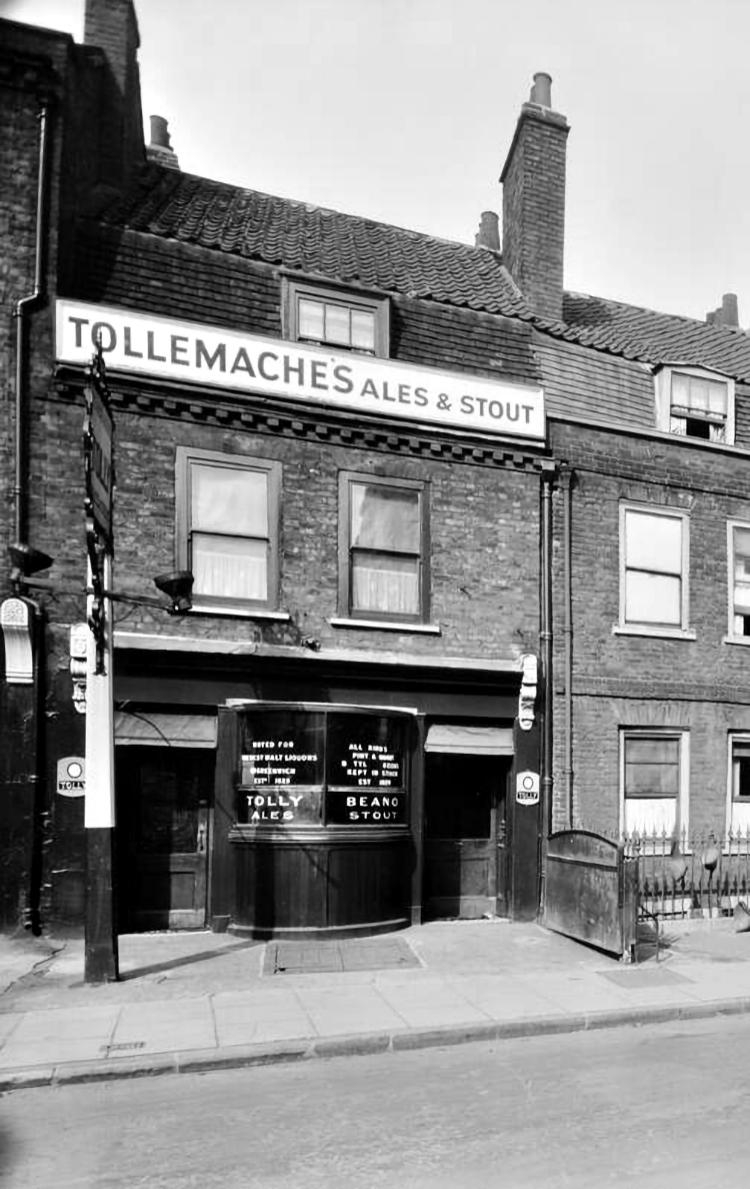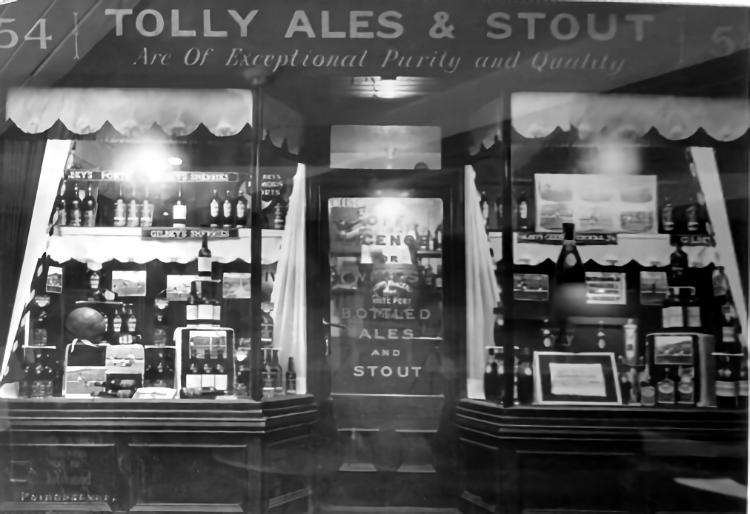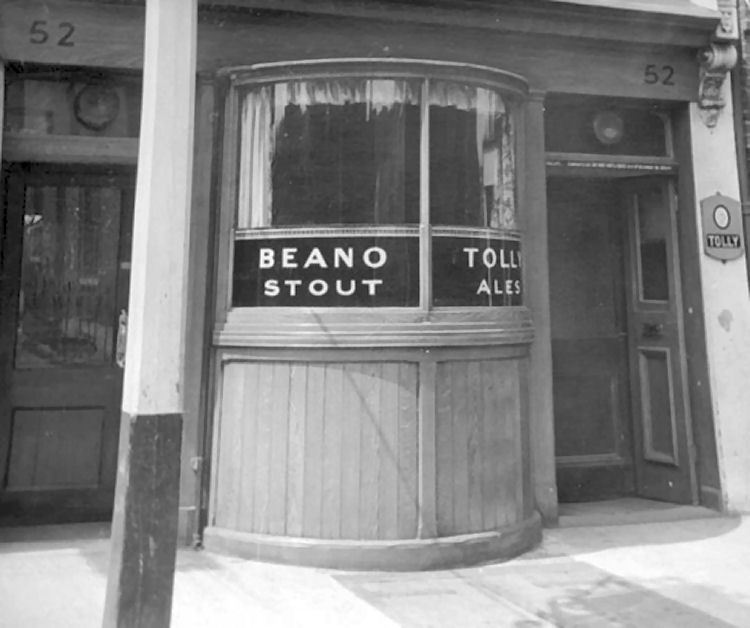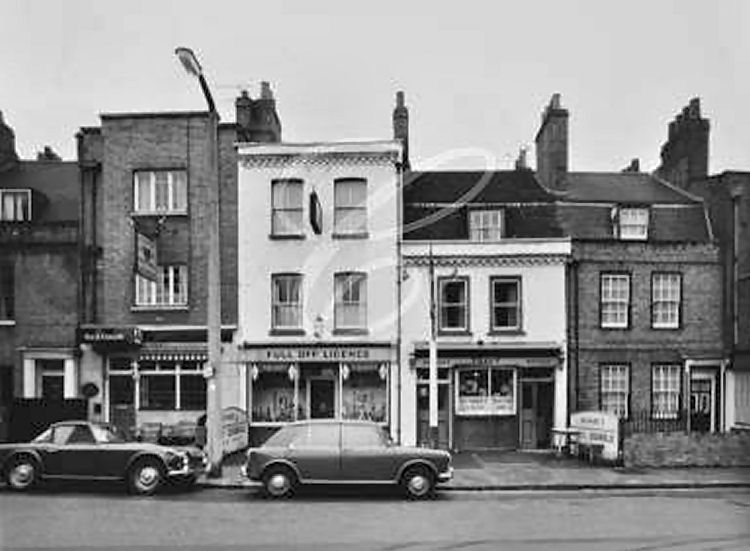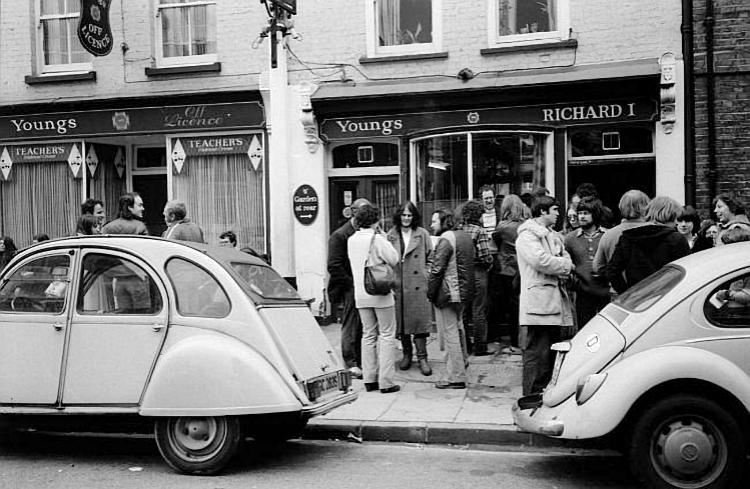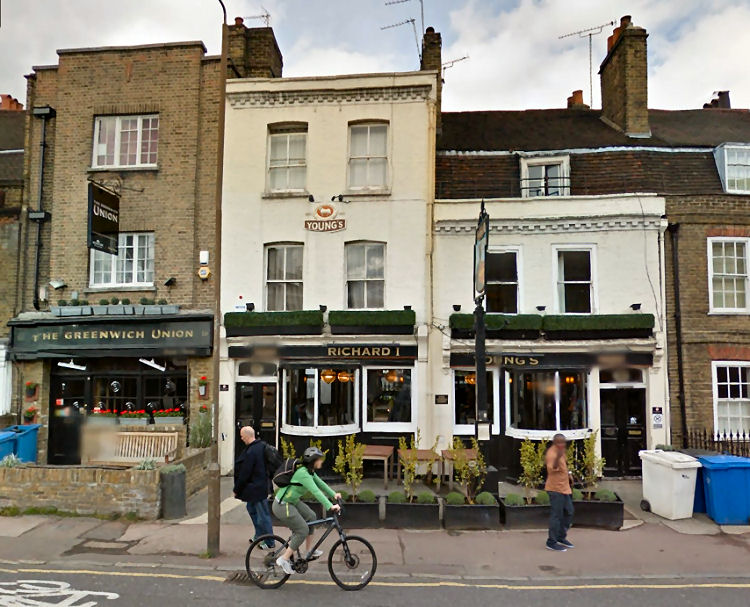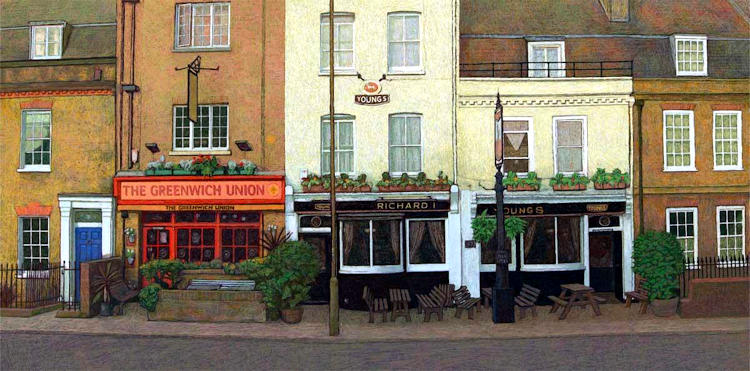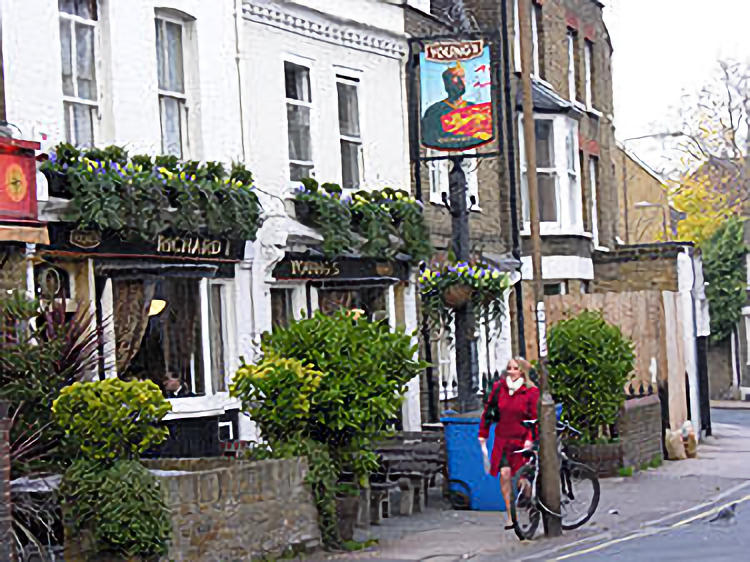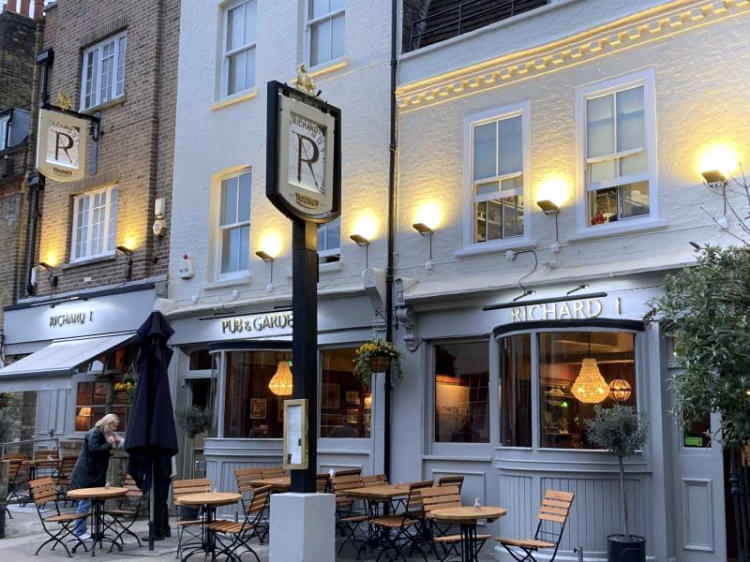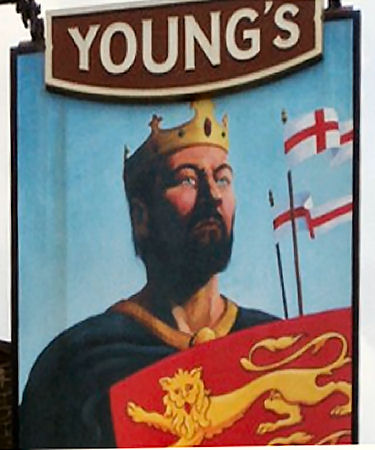|
From
https://thamesfacingeast.wordpress.com
1 June 2013.
I started
going to The Tolly around 1972. The CAMRA real ale revolution started by
Richard Boston in The Guardian had just started and The Tolly, a basic,
back-street boozer, seemed ideal. No 52 Royal Hill, the bit with the
curved window, was a simple, single room bar. No 54, what is now the
public bar, was an off-licence. The off-licence had hardly any stock and
very few customers; although it was possible to buy bottles of Toll
Light Ale which came in a very attractive Perrier-style bottle with a
label featuring an art-noveau statue of a naked Bachante. Arching over
the ground floor windows of the two buildings was a large sign saying
‘Tolly House’. So, like everybody else, I assumed that the pub was
called The Tolly or The Tolly House. Only on close inspection could you
see that ‘Richard I’ was written in the corners of the sign. The single,
wood-floored bar had some simple wooden tables and chairs; the most
prized being the long table and forms in the bay window. The toilet was
outside at the back; and could only be reached by walking through the
backyard. There was no garden.
They have probably been selling beer at 52 Royal Hill almost since the
street was laid out around 1830. Contrary to popular belief, and the
insistence of the residents, the street has no royal connections other
than that is was developed by a Victorian builder called Robert Royal.
It was previously known as the more prosaic Gang Lane. After Royal Hill
had been built the current stretch of Point Hill up to Maidenstone Hill
was known as Royal Hill Row. The bit of Royal Hill which now runs
between Blissett Street and Greenwich South Street was still known as
Green Lane.
The ravages on the working classes of London caused by gin drinking are
well-known. To combat this, The Duke Of Wellington’s Tory government
introduced the 1830 Beer Act designed to encourage beer drinking as an
alternative; beer being much safer than water due to the heat of the
brewing process destroying bacteria. The tax on beer was abolished; and
anybody could apply for a licence, costing 2 guineas, which allowed them
to brew and sell beer in their own houses. (Don’t ever say that a Tory
government ever did anything worthwhile!) Not surprisingly this proved a
very popular measure and Beer Houses, also known as Small Beer Shops or
Tom & Jerry Shops sprung up everywhere. Many of these proved to be
extremely dubious establishments and The 1869 Act put a brake on the
opening of new shops; but those already in existence were allowed to
continue.
The 1860 Greenwich Licensing Guide makes no mention of premises at 52,
54 (or 56, the current Greenwich Union) Royal Hill; the only
establishments there are The "Prince Albert" (now The "Prince Of
Greenwich"), The "Barley Mow" (now The "Hill"), The "Globe," and The "Duke Of
Kent" (demolished 1856). But this lists only Inns, Ale Houses and Victualling Houses. In the 1896 Guide (Unfortunately, the Heritage
Centre only has the 1860, 89, 91 & 96 editions of these fascinating
books) a new section for Licensed Beer Houses, Wine Shops and Grocers
has been added and we now find The "Richard I" at number 52 and The "Fox
and Hounds" at 56. Both establishments are listed as providing Beer, Wine
and Billiards. I don’t know if this is ‘proper’ 3-ball billiards or
Kentish bar-billiards. If is full billiards then I can only assume that
the table was upstairs as there is certainly no room in the current bar.
Given that few Beer Houses were created after 1869, we can assume that
The "Richard I" and The "Fox and Hounds" were in existence well before 1869.
The 1885 census lists Mrs E Dorrington a Beer Retailer at number 52;
Thos Tippen, a florist, at 54 and George Hulby at 56 which is actually
named as The "Fox and Hounds."
The situation continued for the first couple of decades of the1900s. 52
& 56 continued as Beer Houses; but 54 changed to a confectioner. In 1910
54 also opened a Telephone Call Office on the premises to enable to
local residents to make and receive calls on the exciting new telephone
system. The owner of 52 since 1910 was a George Honeybone and in 1923 he
managed to buy 54 and to merge the two building to create his beer
empire at The "Richard I."
At some stage the business was taken over and the pub supplied by The
Tollmache Brewery Company which later merged with the Cobbold Company to
form the Tolly Cobbold brewery based in Ipswich. Hence the sign; which
is where we first came in.
The Tolly had always been a basic
working-class boozer.. the pub has many evocative photos of old
charabanc trips hanging on the walls. However, with the CAMRA revolution
and the transformation of West Greenwich’s Victorian terraces into
highly desirable bijou residences, it rapidly became transformed into a
heaving, standing-room only mass of students, academics, media-types and
others generally classified as Guardian readers. Many came for the
real-ale; but others, such as myself, preferred the large bottles of
Holsten lager that were sold; well before the general availability of
strong continental lagers like Stella. Soon the only trace of the old
working class was the old bloke in the cloth cap who collected the
Christmas Club money every Monday and the pickled-eggs which remained
the only food available. The trendiness probably reached its peak when
we were treated to melodies from Jules Holland on the old piano in the
back on the way to the outside toilet.
When I started the landlord was
a genial old Cockney geezer called ’Arry who we all thought was married
to a very large lady called Hilda who spent all her time perched on a
stool by the bar. ‘Arry’s assistant was a bloke called John Ling who was
distinguished by his dislike of the way the pub was going and his hatred
of the new clientele. His particular dislike was anybody who tried to
create a group of 5 by moving a chair from one group of 4 round a table
to another. ‘Don’t move the chairs’; he would scream across the room.
When ‘Arry died in 1976 John took over the licence and we thought that
he had married Hilda. But census records show that 52-54 was occupied by
Henry C and Rose French from 1969 to 1976. Presumably Henry was ‘Arry;
but I am sure I never saw Rose. And from 1964 to 1967 52-54 was occupied
not only by the Roses but also by Fredrick and Joan Lambert. The only
time it has been under multi-occupation. So I’m not really sure what was
going on there.
In the late-1970s, a drivers’ strike at the brewery
affected supplies to The Tolly, and Tolly Cobbold indicated to John Ling
that it was not worth keeping their remote outpost in SE10 open.
However, Young’s Brewery stepped in and took over the lease. A friend
assures me that this happened because he was so upset at the prospect of
losing his favourite pub that he wrote a personal letter to Sir John
Young pointing out that The Tolly would make a great asset in the
Young’s estate and this had spurred Youngs into the takeover. Whether
this is true or not, we will never know.
Traditionalists were
delighted that a brewer like Youngs had taken over the Tolly. However,
one of things that they did was to give the place a complete refit.
Obviously, the first thing to go was the Tolly sign and its replacement
with a large Richard I sign together with a much more distinct sign on
the street column. The off-licence was converted into what is now the
public bar and the back was extended to provide the luxury of indoor
toilets. A nice beer garden was also built.
The Tolly has been a
Young’s house for the past 30-odd years and it has always had more of a
corporate feel than the pub under ‘Arry and John. Managers have come and
gone without any really establishing a personality for themselves; and
the bar staff tend to be the usual crowd of itinerant antipodeans and,
more lately, east Europeans. Youngs corporate food and wine is available
and the usual pub gimmicks; quiz night (Sunday nights, can be
entertaining), curry nights; burger nights; poker nights come and go.
A couple of years ago we had another renovation; ubiquitous innovations
like distressed sofas were introduced; and, to the horror of
traditionalists, they even put down a carpet in the lounge bar. The
furniture in the public bar can make the place look like a giant’s
living room.
At one time I thought The Tolly was the best pub in the
world; now I’m not even sure that it’s the best pub in 52-56 Royal Hill.
So much for the trip down Memory Hill. The "Richard I" seems to be the
only establishment on Royal Hill which kept the same identity since its
foundation in 1830. Ironic, since for at least 40 years it has been
generally known by a completely different name.
Thanks to the staff at
Greenwich Heritage Centre for their assistance.
My first two postings
tracked my gradual disillusionment with the corporatisation of The Tolly.
I think much of this can be put down to the transition of Youngs, the
owners, from an independent brewer with a small chain of pubs in South
London to a subsidiary of Charles Wells. Charles Wells now not only brew
Young’s beer but also that of Courage and McEwan’s. However, this
feeling is as nothing now that I have seen what is proposed for the
future.
The Tolly has been closed for refurbishment since March 2014.
Details of what is planned have now been posted here.
The Tolly mood-board.
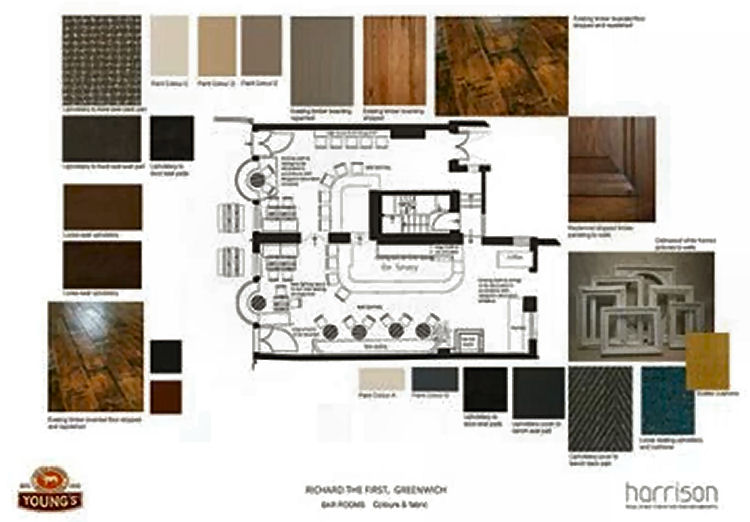
I have studied Mood Boards (urrgh!) 1 & 2 with some difficulty as I have
found it impossible to read the script; but essentially I think they
propose to merge the public and lounge bars by knocking through the
dividing wall at the Royal Hill end. A considerable loss of seating also
seems to be involved. The area from the back of the current bar in the
lounge to some distance into the garden will be a giant
restaurant/conservatory. The whole lot will be kitted out from some
central warehouse with all sorts of ersatz French shabby chic fixtures
and fittings.
Mood-board-2.
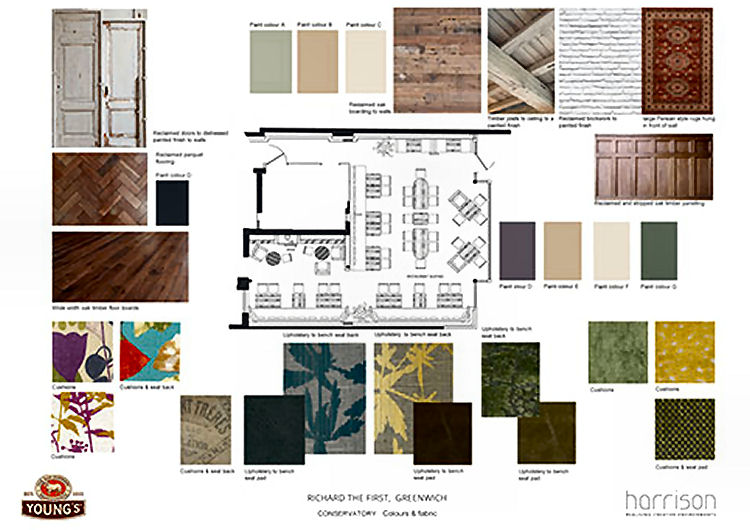
The size and layout of the front bar, it only has two full size tables,
seems to indicate that it isn’t really designed as a serious drinking
establishment but is just some sort of holding area for the dining room
which is where the real action will be. So, it looks like The Tolly will
be a restaurant with a small bar attached.
What sort of a restaurant will it be? Young’s do a corporate menu of the
usual pub standards; crab cakes, goats cheese tarts, battered fish and
chips; bangers and mash and burgers. The sort of thing you can find
anywhere. Perhaps the pub that The Tolly will most resemble would be
somewhere like The Dulwich Woodhouse. However, there are two main
problems if The Tolly is to make a success of being a successful
purveyor of pub grub. First, it has very little passing trade and why
should anybody want to make the journey; and second, it is next to
impossible to park anywhere near in the day, and still difficult in the
evening, again why should anybody make the effort.
Perhaps they hope to turn the old place into a gastropub with its own
gourmet menu. The problem with this is that are already two such
establishments, The "Hill" and The "Prince of Greenwich," within fifty
yards, and also an artisan craft brewery/restaurant next door. Throw in
the nearby North Pole, Davy’s and The Rivington and I reckon that Royal
Hill needs another gastropub as much as Blackheath Village needs a new
Estate Agent.
So, who will be flocking to dine in this wonderful new conservatory?
Perhaps the new residents of the area’s rapidly proliferating luxury
apartments will stop drinking their Sauvignon Blanc on their Juliet
Balconies; abandon their Waitrose ready meals in their designer
kitchens, and flood across Greenwich South Street. But this is unlikely,
especially as most of them would find it a bit of a slog from Singapore
or Hong Kong.
Is this the end of The Tolly? A corporate gastropub among so many
others. What would Harry and John and their pickled eggs have made of
it?
And can anybody explain the bicycle?
Guest Post by BK
|
